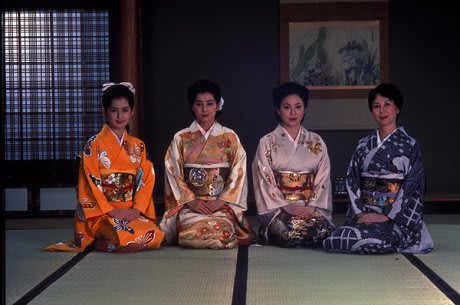Widely considered to be among the grandmasters of Japanese cinema, Kon Ichikawa displays a lot of deliberate restraint in his 1983 adaptation of Jun'ichiro Tanizaki's novel of the same name.
Some might criticize the versatile director's approach as being a bit underwhelming, but for the cinematography and editing to emphasise every emotional beat of this turbulent melodrama would be overkill.
With the casting of Keiko Kishi, Yoshiko Sakuma, Sayuri Yoshinaga and Yuko Kotegawa as the titular Makioka Sisters, Ichikawa is clearly more interested in saving the fireworks for his actors while he subtly alters his shooting style as the film progresses in order to compliment the changing state of Japanese culture during the pre-World War II period being depicted.
The story chronicles a year in the life of four sisters who come from old money and strict traditions. They gather every spring to watch the cherry blossoms in Kyoto and with the season, the story begins on a note of hope and renewal as the elder siblings discuss vetting suitable husbands for their younger sisters.
Most of the story unfolds around attempts to partner up Yukiko (Yoshinaga), the second youngest and least interested in being married off, because it's tradition for sisters to wed in descending order of age. Taeko, the youngest, has plenty of suitors – including the lazy son of a rich business man and a humble photographer – and even less respect for outmoded customs, choosing to pursue independence by making her own money crafting custom dolls.
The husbands of status-obsessed matriarchs, Tsuruko and Sachiko, are rather deferent to their spouses, honoured to have married into the Makioka family name, even though Tatsuo harbours resentment for his underappreciated hard work. And Teinosuke has a barely concealed crush on Yukiko, the reasons for and implications of which are under-explored.
As the film progresses, a past transgression that besmirched the family name shown (mostly) in black and white flashbacks is presented as a catalyst behind much of the tension within the family. Not only is this a chronological tool for the viewer to know when it's 1938 and when it's earlier, but the stark chromatic divide also represents the inflexible position of traditional sensibilities.
To further the visual symbolism of old methods being forced into modernity by unavoidable progress, Ichikawa lets his camera – entirely static for the first half of the film – begin to move as festering passive-aggressive spite is lanced and self-aware emotional admissions begin to leak out among the family members.
Overall, it's a beautiful, well-acted work packed with gorgeous art design, but one that falls prey to the occasional indulgence – bloated scenes, garish synthesizer music – that detracts from the film's impact.
The Makioka Sisters screens at the TIFF Bell Lightbox as part of the Japanese Divas retrospective at 7:30pm on Sunday, January 27th, 2013.
(Toho Company)Some might criticize the versatile director's approach as being a bit underwhelming, but for the cinematography and editing to emphasise every emotional beat of this turbulent melodrama would be overkill.
With the casting of Keiko Kishi, Yoshiko Sakuma, Sayuri Yoshinaga and Yuko Kotegawa as the titular Makioka Sisters, Ichikawa is clearly more interested in saving the fireworks for his actors while he subtly alters his shooting style as the film progresses in order to compliment the changing state of Japanese culture during the pre-World War II period being depicted.
The story chronicles a year in the life of four sisters who come from old money and strict traditions. They gather every spring to watch the cherry blossoms in Kyoto and with the season, the story begins on a note of hope and renewal as the elder siblings discuss vetting suitable husbands for their younger sisters.
Most of the story unfolds around attempts to partner up Yukiko (Yoshinaga), the second youngest and least interested in being married off, because it's tradition for sisters to wed in descending order of age. Taeko, the youngest, has plenty of suitors – including the lazy son of a rich business man and a humble photographer – and even less respect for outmoded customs, choosing to pursue independence by making her own money crafting custom dolls.
The husbands of status-obsessed matriarchs, Tsuruko and Sachiko, are rather deferent to their spouses, honoured to have married into the Makioka family name, even though Tatsuo harbours resentment for his underappreciated hard work. And Teinosuke has a barely concealed crush on Yukiko, the reasons for and implications of which are under-explored.
As the film progresses, a past transgression that besmirched the family name shown (mostly) in black and white flashbacks is presented as a catalyst behind much of the tension within the family. Not only is this a chronological tool for the viewer to know when it's 1938 and when it's earlier, but the stark chromatic divide also represents the inflexible position of traditional sensibilities.
To further the visual symbolism of old methods being forced into modernity by unavoidable progress, Ichikawa lets his camera – entirely static for the first half of the film – begin to move as festering passive-aggressive spite is lanced and self-aware emotional admissions begin to leak out among the family members.
Overall, it's a beautiful, well-acted work packed with gorgeous art design, but one that falls prey to the occasional indulgence – bloated scenes, garish synthesizer music – that detracts from the film's impact.
The Makioka Sisters screens at the TIFF Bell Lightbox as part of the Japanese Divas retrospective at 7:30pm on Sunday, January 27th, 2013.
